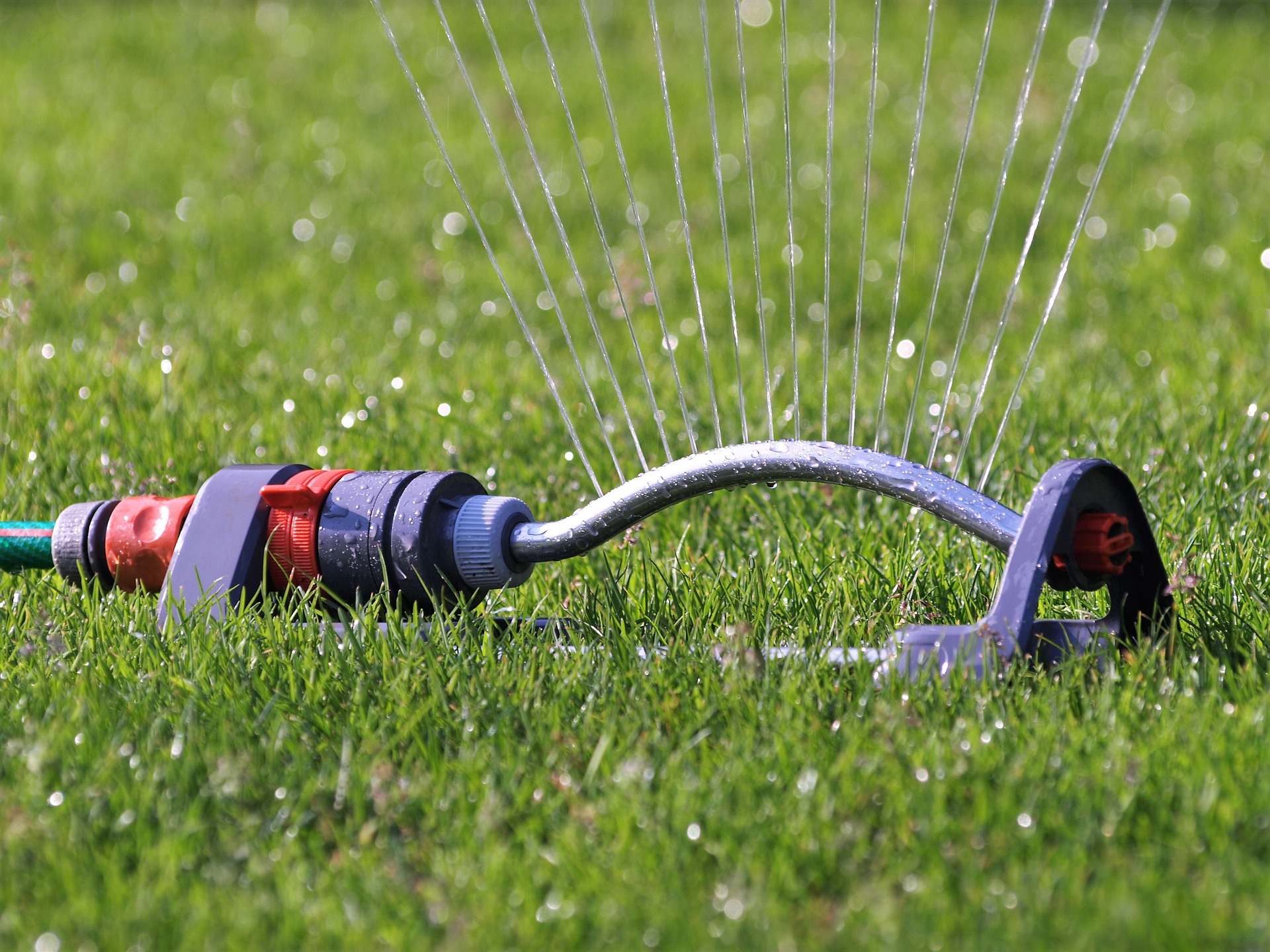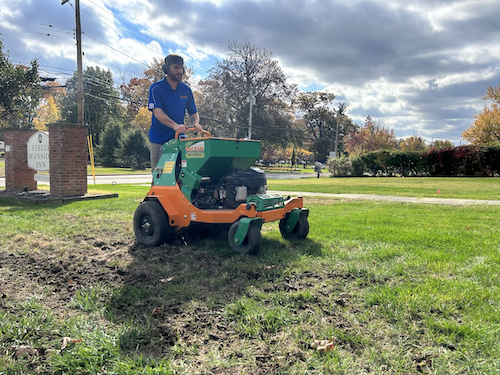/technician%20taking%20machine%20out%20of%20truck.jpg)
Lawn Care for Beginners: Where to Start and What to Avoid
In spring, as the weather warms and it’s time to see how your grass survived the winter, you might find yourself standing in the middle of your lawn scratching your head and feeling confused.
What on earth are these bare and brown spots? Didn’t your lawn just look good last summer? Why are some areas green and others dull, yellow, or brown? Are those patches of weeds?
/Technician%20showing%20brown%20spot%20on%20lawn.jpg?width=872&height=491&name=Technician%20showing%20brown%20spot%20on%20lawn.jpg)
We know it can be overwhelming. What can you do to get your lawn in shape? How low should you be mowing? How often should you water your lawn? What are the best ways to rid your lawn of weeds? Does your lawn need fertilizer and how often?
We know lawn care can seem complicated. It’s based on science, after all. And unless you have studied the basics of turf agronomy, we completely understand that it can be tough to figure out where to begin with grass maintenance.
Whether this is your first home or a new yard, you may be craving a little refresher on beginner lawn care to give yourself the knowledge of how to do things right. We’ve got you covered. Here is a guide on some key areas so you can better maintain your lawn and become more comfortable in understanding what your lawn needs.
6 Key Beginner Lawn Care Tips
We know you don’t have the time or energy to learn an entirely new skillset, but we want you to get the best results with your grass maintenance.
Prioritizing the following elements should help get you there so you can be confident and boast a great looking lawn in your Northeast Ohio neighborhood.
Proper Watering Is Important
You might think Mother Nature provides enough moisture for your lawn, but in some years it really doesn’t. And water is essential to your lawn’s overall performance and vigor. For the optimum thickness and health, your lawn needs water.
If you see yellow grass blades or an overall loss of vigor, this could be the result of insufficient water or even drought stress.
That’s why care for the lawn includes adding about 2 inches of water weekly. When the weather doesn’t deliver what your lawn needs, you need to add water with an irrigation system or supplemental watering of some kind.
In addition to inadequate water, lawns can also receive too much water. In this case, you’ll see yellowing or spots in your lawn and assume it’s drought when, in fact, it’s a lawn disease caused by overwatering.
Your watering should be done deeper and longer and less frequently to reach your weekly water goal and encourage deeper, stronger roots and greener, healthier grass. Also, you want to water early in the morning before sunrise. This is because wind and sun can evaporate your water before it can soak into the soil where it’s needed.

Mow to Maximize Lawn Vitality
Another beginner lawn care tip is proper mowing.
The mowing mistakes you can make can actually add up. You can mow to the wrong height, mow at the wrong frequency, and use unmaintained mowing equipment with unsharpened mower blades that tear your lawn.
The best Northeast Ohio lawn height is 3 to 4 inches. This height optimizes your lawn health, keeping it growing thick and green and helping to block weed germination. You might be tempted to cut your lawn short to look like your favorite golf course. Cutting your lawn too short stresses it out and could cause yellowing or browning, and even let weeds in.
Weekly mowing is usually adequate during the growing season. You should only be cutting one-third of the grass blades at any one time to reach that maximum height of 3 to 4 inches.
/lawn%20mowing%20height.jpg?width=5168&height=2912&name=lawn%20mowing%20height.jpg)
Sharp mower blades and a level mowing deck can produce a fine and even cut. Checking your tires for proper inflation is also crucial to ensuring that consistent cut.
The Essentials of Lawn Fertilization
When developers build homes, they move soil around, stripping it of nutrients and organic matter in the process. This doesn’t create the ideal environment for growing anything – especially grass.
That’s why your lawn needs fertilization as a part of essential care for a lawn. But one random application here or there doesn’t help.
A consistent fertilization schedule can keep building your grass up. Fertilization is as important in the spring when the growing season is kicking off as it is in the fall when the growing season is settling down. That way you’re building top growth and root growth at the time when both of those things are happening.

Going Beyond Fertilization
In addition to fertilization, maintaining a comprehensive grass maintenance program is important to your lawn’s overall health.
One such service that usually comes with fertilization in a lawn care program is pre-emergent and post-emergent weed control.
Pre-emergent herbicides target weed seeds before they germinate. This is important for weeds like crabgrass that are much easier to control before they sprout. Post-emergent products, on the other hand, tackle those weeds that have already emerged.
/Live%20Website%20Images/crabgrass-in-lawn.jpg?width=1200&height=676&name=crabgrass-in-lawn.jpg)
Unfortunately, there are multiple types of weeds that can invade your lawn at different times of year, so you want to stay ahead of them all. A comprehensive lawn care program can cover fertilization and weed control in one, giving you those multiple treatments at the right times throughout the year.
Aeration Has Many Advantages
You may have your beginner lawn care basics covered. We’re talking about mowing, watering, fertilization, and weed control. But maybe your lawn still seems unwell.
It could need aeration. When your soil becomes compacted from years of traffic and rainfall, it can’t breathe. When it gets to this point, your lawn can’t take in water or nutrients the way it should; it’s basically starving.

Lawn aeration is the practice of using a special machine to pull out soil plugs and redeposit them along the lawn. This creates air pockets so roots can thrive, receiving water and oxygen. Healthier roots make a thicker, healthier lawn. And you know a healthier lawn is more resistant to weeds, diseases, and drought.
Don’t Be Afraid to Call a Pro
Our final beginner lawn care tip is calling in a professional for your lawn care services.
Lawn care can be a lot to take on. We completely understand. Whether you’re at your first home or your third, handling our lawn care on your own can take up a lot of time you don’t have.
You might even think you can save money doing it on your own.
But, in reality, everything from application timing to weed and insect identification to lawn care knowledge is a lot to take on. And if you miss a beat – whether it’s focusing on your full-time job or taking care of your family – your lawn can suffer.
It’s perfectly OK to eliminate the hassles and headaches and hire a trusted professional to take care of your lawn.
/TurfPrideSpring2022(WebOptimized)-300.jpg?width=5168&height=2912&name=TurfPrideSpring2022(WebOptimized)-300.jpg)
The Right Partner Can Help With Your Lawn Care
We hope these grass maintenance tips for Northeast Ohio lawns help you. You may want to give them a try, and we hope this pays off for you with a greener, thicker lawn that you can enjoy day in and day out.
But if you’re having trouble figuring out where to start, we understand. Let Turf Pride help. We bring years of lawn care service experience and can help you solve your issues quickly and smoothly, so you can spend time enjoying your lawn instead of constantly thinking about how to fight weeds or battle disease.

Wondering if you need professional lawn care services in Northeast Ohio? Get started today with a free quote. We’ll review your options together so you can make a great choice. Then you can just sit back and enjoy your lawn.


